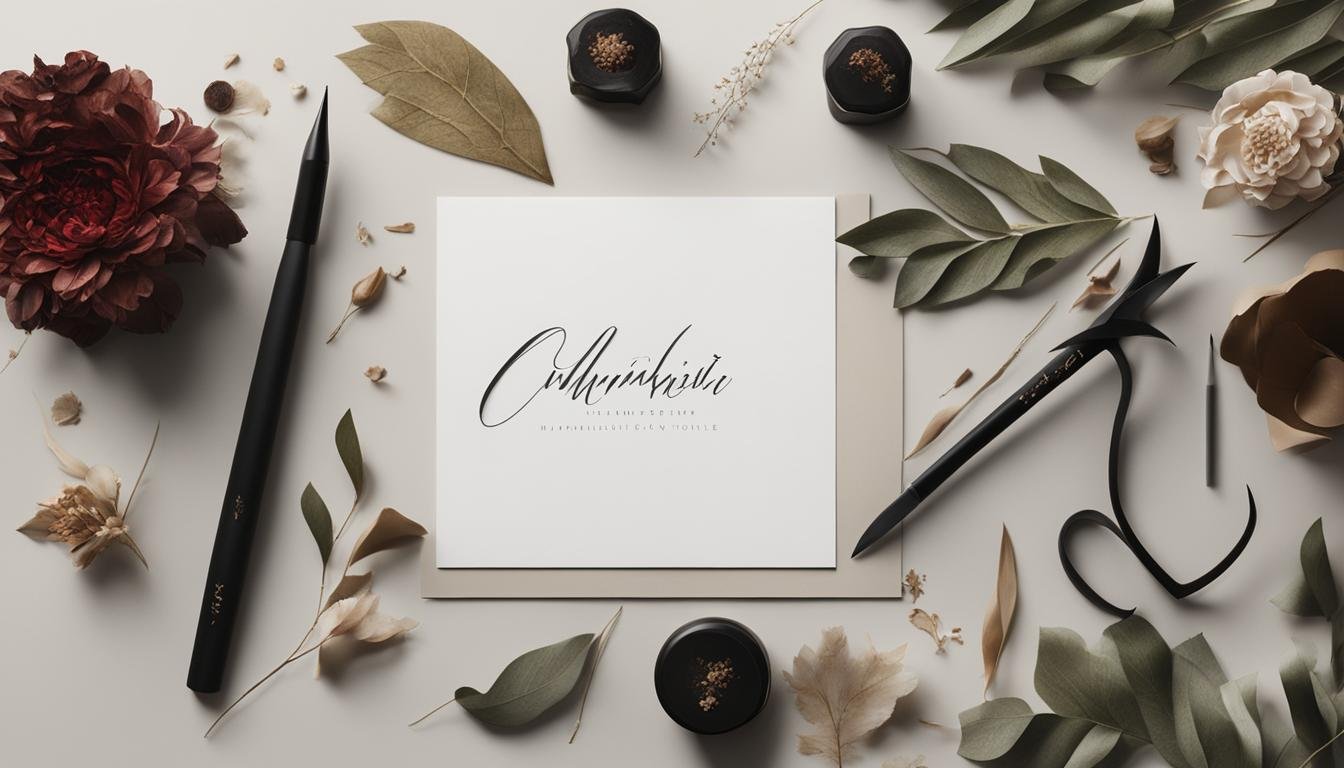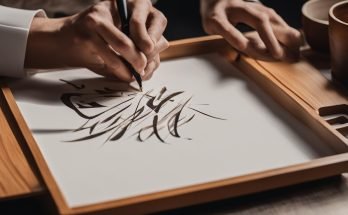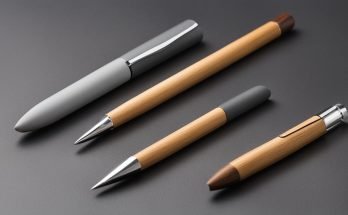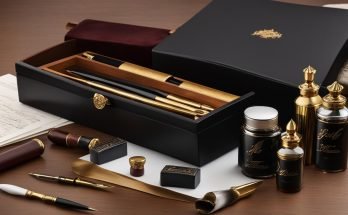Modern Calligraphy Tools Unleashed: Transform Your Writing with the Latest Gear!
Welcome to the world of modern calligraphy! This beautiful art form allows you to express your creativity through the written word. But to create stunning lettering and achieve precise strokes, you’ll need the right tools. In this article, we’ll explore the top modern calligraphy tools and supplies available in the market today.
Key Takeaways:
- Modern calligraphy tools are essential for creating beautiful lettering.
- Brush pens, digital calligraphy tablets, and flexible nib fountain pens are popular tools for modern calligraphy.
- Choosing the right calligraphy paper is crucial for achieving the desired look and feel of your lettering.
- Other calligraphy tools and accessories can enhance your modern calligraphy experience.
- Experimenting with different pens, papers, and techniques will help you find your unique calligraphy style.
Essential Starter Kits for Beginning Calligraphers
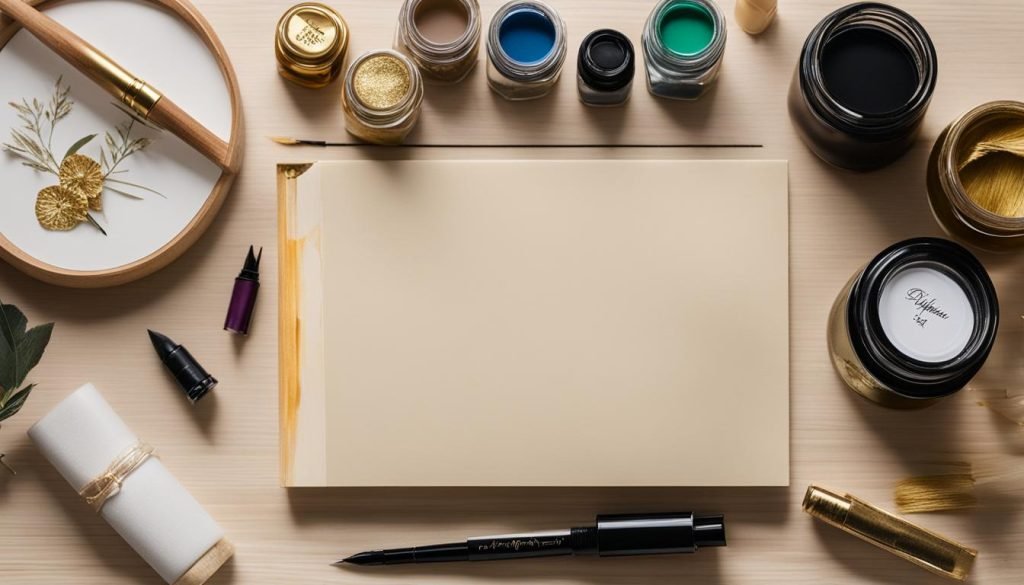
For those new to modern calligraphy, starter kits are an excellent choice. These kits come with all the essential tools you need to get started on your calligraphy journey. Some popular starter kits include the Tombow Starter Kit for beginners, Tombow advanced lettering set, Staedtler Mars Lumograph Wooden Lead Pencil bundle, Amazon drawing pack, drafting kit, and watercolor starter kit. These kits provide everything from pens and pencils to watercolors and paper, making it easy for beginners to practice and experiment with different techniques.
When choosing a starter kit, it’s essential to consider the quality of the tools included. Look for kits that offer pens with smooth ink flow and comfortable grips, as these factors greatly affect your calligraphy experience. Beginner-friendly calligraphy tools often have flexible nibs or brush tips that allow for easier control and smoother strokes. Additionally, consider the type of paper included in the kit, as it should be suitable for calligraphy ink and minimize bleeding or feathering.
Investing in a modern calligraphy starter kit is a cost-effective way to explore this beautiful art form without the hassle of selecting individual tools. With a comprehensive set at your disposal, you can dive right into practicing various lettering styles and techniques. As you gain more experience and confidence, you can gradually expand your collection of calligraphy supplies and experiment with different brands and tools to enhance your skills further.
Table: Comparison of Popular Modern Calligraphy Starter Kits
| Starter Kit | Included Tools | Price Range | Noteworthy Features |
|---|---|---|---|
| Tombow Starter Kit | Brush pens, pencils, blending palette, eraser | $20 – $30 | High-quality brush pens with flexible tips |
| Tombow Advanced Lettering Set | Brush pens, dual brush pens, blending palette, pencil | $30 – $40 | Wide range of brush pen colors for lettering versatility |
| Staedtler Mars Lumograph Wooden Lead Pencil bundle | Wooden lead pencils, sharpener, eraser | $10 – $20 | Premium quality graphite pencils for sketching and drafting |
| Amazon Drawing Pack | Drawing pens, sketching pencils, sketchbook | $15 – $25 | Diverse range of pens and pencils for different drawing techniques |
| Drafting Kit | Drafting pens, templates, ruler, eraser | $25 – $35 | Specialized tools for precise technical drawing and drafting |
| Watercolor Starter Kit | Watercolor paints, brushes, watercolor paper, palette | $30 – $40 | High-quality watercolor paints and brushes for vibrant artwork |
Table: Comparison of Popular Modern Calligraphy Starter Kits
Brush Pens for Smooth and Fluid Lettering
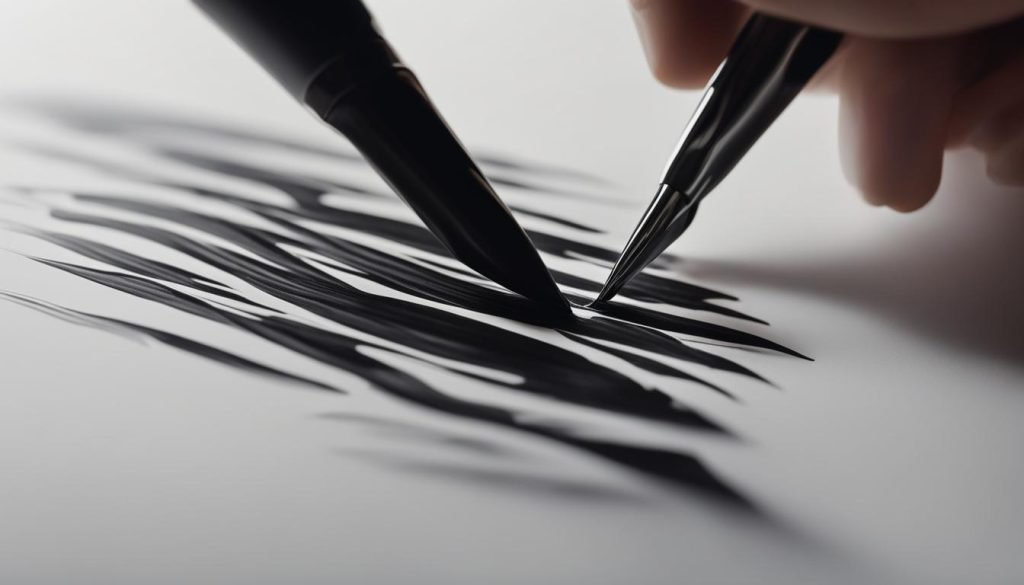
When it comes to modern calligraphy, brush pens are a game-changer. These versatile tools allow you to create smooth and fluid lettering with ease. The flexible bristles of brush pens provide excellent control and allow for a wide range of line variations, making them perfect for calligraphy and lettering projects.
There are several popular brush pens available in the market that are specifically designed for calligraphy. The Tombow Fudenosuke Brush Pen Set is a favorite among calligraphers for its fine and extra-fine tips, which are perfect for creating intricate details. The Pentel Fude Touch Pen is another great option, known for its durable brush tip and vibrant ink colors.
For those looking for a more extensive color selection, the Tombow Dual Brush Pen is a fantastic choice. With a dual-tip design and a wide range of colors available, this brush pen allows you to create vibrant and colorful lettering. Other popular brush pen options include the Kuretake Fudebiyori brush pens, Sharpie Brush Tip Permanent Marker, Crayola Super Tip Markers, Tombow Fudenosuke 10 color pack, Pentel Arts Sign Pen Touch, and Artline Stix.
Comparison Table: Popular Brush Pens for Calligraphy
| Brand | Model | Features | Ink Colors |
|---|---|---|---|
| Tombow | Fudenosuke Brush Pen Set | Fine and extra-fine tips | Black, gray, brown |
| Pentel | Fude Touch Pen | Durable brush tip | Black, blue, red, green |
| Tombow | Dual Brush Pen | Dual-tip design | Wide range of colors available |
| Kuretake | Fudebiyori brush pens | Flexible brush tip | Wide range of colors available |
| Sharpie | Brush Tip Permanent Marker | Quick-drying and fade-resistant | Wide range of colors available |
| Crayola | Super Tip Markers | Washable and non-toxic | Wide range of colors available |
With the variety of brush pens available, you can experiment with different brands, tips, and ink colors to find the ones that suit your style and project requirements. Whether you’re a beginner or an experienced calligrapher, brush pens are the perfect tool to add grace and fluidity to your lettering.
Exploring Different Calligraphy Papers

When it comes to modern calligraphy, one often overlooked but essential aspect is the choice of calligraphy paper. The right paper can make a significant difference in the overall look and quality of your lettering. Smooth calligraphy paper is particularly crucial as it allows your brush pens to glide effortlessly, resulting in clean and precise strokes. In this section, we will explore some popular options for calligraphy paper that will enhance your calligraphy experience.
Smooth Calligraphy Papers for Effortless Stroke
1. Rhodia 80 Sheet Dot Pad: This high-quality paper provides a smooth surface for your brush pens, allowing them to flow across the page with ease. The dot grid pattern ensures precise lettering placement and proportion.
2. Canson Tracing Paper Pad: This pad is excellent for practicing calligraphy as it offers a smooth surface and minimal bleed-through. It is ideal for inking and tracing your lettering to perfection.
3. HP Smooth Choice Laserjet Paper: If you’re looking for a more affordable option, this paper is a good choice. It has a smooth texture that works well with brush pens, making it suitable for practicing drills and honing your skills.
Other Considerations for Calligraphy Paper
- Choose papers that are specifically designed for calligraphy to ensure optimal ink absorption and smoothness.
- Avoid textured or rough papers, as they can interfere with the precision of your strokes.
- If you prefer a lighter-weight option, consider using tracing paper for its smooth surface and transparency, which allows for easy tracing and layering of lettering.
Remember, the choice of calligraphy paper is crucial for achieving beautiful and professional-looking lettering. Experiment with different papers to find the one that works best for your preferred techniques and personal preferences.
Modern Calligraphy Fountain and Dip Pens: Tools for Fine Calligraphy Work
When it comes to creating fine calligraphy, modern calligraphy fountain pens and dip pens are essential tools that provide precision and control. These pens allow calligraphers to achieve delicate and intricate lettering with varying line widths. Let’s explore some popular options for modern calligraphy fountain pens, dip pens, and flexible nibs:
Fountain Pens:
Fountain pens are an excellent choice for calligraphers seeking elegance and ease of use. The Sailor Hocoro Feed-less Fountain Pen Nib and the Pilot Parallel Pen are highly recommended for their smooth writing experience and consistent ink flow. Whether you prefer a sleek and modern design or a vintage-inspired pen, there are plenty of options available to suit your style and preferences.
Dip Pens:
Dip pens are versatile tools that allow calligraphers to experiment with various nibs and inks. The Gillott 303 Nib, Hunt 101 Nib, Leonardt Principal EF Nib, and Hiro/Leonardt #40 Nib (Blue Pumpkin Nib) are popular choices for their flexibility and ability to create different line widths. Dip pens offer the flexibility to switch between nibs and inks, giving calligraphers the freedom to explore different styles and techniques.
| Fountain Pens | Dip Pens |
|---|---|
| Sailor Hocoro Feed-less Fountain Pen Nib | Gillott 303 Nib |
| Pilot Parallel Pen | Hunt 101 Nib |
| – | Leonardt Principal EF Nib |
| – | Hiro/Leonardt #40 Nib (Blue Pumpkin Nib) |
Whether you choose a modern calligraphy fountain pen or a dip pen, having a flexible nib is crucial for achieving beautiful lettering. The flexibility of the nib allows you to apply varying pressure, resulting in both thick and thin strokes in your calligraphy work. Experimenting with different pens, nibs, and inks will help you find the perfect combination that suits your style and brings your artistic vision to life.
Remember, the choice of tools will ultimately depend on your personal preferences and the style of calligraphy you wish to create. Whether you prefer the convenience of a fountain pen or the versatility of a dip pen, both options offer a world of possibilities for calligraphers to explore and master their craft.
Exploring Other Calligraphy Tools and Accessories
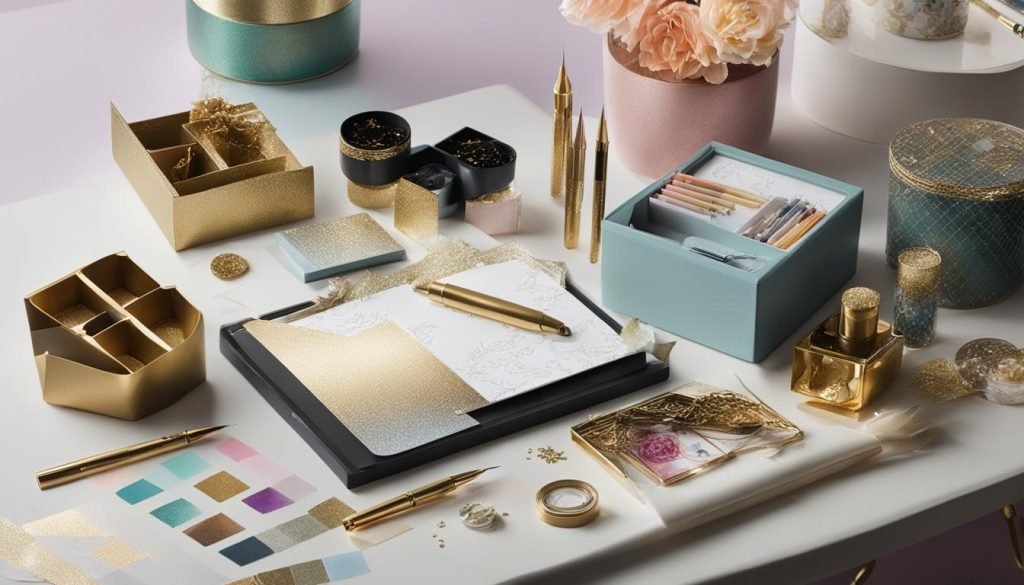
In addition to pens and paper, there are various other calligraphy tools and accessories available that can enhance your modern calligraphy experience. These tools are designed to meet the specific needs of calligraphers and help them create stunning lettering. Whether you’re a beginner or an experienced calligrapher, incorporating these tools into your practice can take your artwork to the next level.
Calligraphy Accessories
Calligraphy accessories play an important role in aiding precision, creativity, and efficiency in calligraphy work. Some popular calligraphy accessories include:
- Calligraphy rulers with modern designs: These rulers come in various shapes and sizes, making it easier to create straight lines and precise angles in your lettering.
- Calligraphy pen travel cases: These cases provide protective storage for your calligraphy pens and prevent them from getting damaged while you’re on the go.
- Calligraphy pen cleaning solutions: Keeping your calligraphy pens clean is essential for maintaining their performance. Calligraphy pen cleaning solutions help remove ink residue and prolong the life of your pens.
Modern Calligraphy Supplies
In addition to pens and accessories, there are other modern calligraphy supplies that can enhance your creative process. Some popular modern calligraphy supplies include:
- Zig Journal & Title Marker: These markers are perfect for creating bold and eye-catching lettering in your journals, scrapbooks, and other creative projects.
- Gel pens set: Gel pens offer smooth and vibrant ink that is perfect for adding intricate details and embellishments to your calligraphy artwork.
- Calligraphy airbrush systems: Airbrush systems allow you to create stunning gradients and effects in your calligraphy work, adding depth and dimension to your lettering.
By incorporating these calligraphy tools and accessories into your practice, you can explore new techniques, enhance your creativity, and achieve beautiful and unique lettering in your modern calligraphy artwork.
Tips for Choosing the Right Calligraphy Pen
When it comes to calligraphy, selecting the right pen is crucial for achieving the desired artistic results. Whether you’re a beginner or an experienced calligrapher, here are some tips to help you choose the perfect calligraphy pen:
Consider Your Skill Level
When choosing a calligraphy pen, it’s important to consider your skill level. If you’re just starting out, opt for ballpoint pens or fountain pens with a beginner-friendly design. These pens offer ease of use and familiarity, allowing you to focus on developing your lettering techniques.
Explore Different Pen Types
Calligraphy pens come in different types, each offering its own unique feel and line variation. Dip pens with various nib options provide flexibility and control, making them suitable for intermediate to advanced calligraphers. Brush pens, on the other hand, are popular for their ability to create smooth and fluid lettering. Experiment with different pen types to find the one that aligns with your style and preferences.
Consider Hand Pressure
Hand pressure plays a crucial role in calligraphy. Some pens require more or less pressure to achieve the desired thick and thin strokes. Consider how much pressure you naturally apply when writing and choose a pen that complements your hand pressure. This will ensure a comfortable writing experience and consistent results in your calligraphy work.
By following these tips and considering your skill level, exploring different pen types, and taking hand pressure into account, you can choose the perfect calligraphy pen that suits your needs and helps you create beautiful lettering.
Tips for Choosing the Right Calligraphy Paper
When it comes to modern calligraphy, the choice of paper is crucial in achieving the desired lettering outcome. The right paper can enhance your writing experience, allowing your brush pen ink to flow smoothly without bleeding or feathering. To choose the perfect calligraphy paper, consider the following tips:
1. Opt for Smooth Surfaces
Smooth paper surfaces, like the Rhodia 80 Sheet Dot Pad and the Canson Tracing Paper Pad, provide an ideal canvas for calligraphy. These papers prevent your brush pen from catching on the surface, allowing for effortless strokes and precise letterforms. Avoid textured papers, as they may interfere with the smoothness of your writing.
2. Consider Thickness
Thicker calligraphy papers tend to be more durable and prevent ink from bleeding through to the other side. Look for papers with a suitable weight to achieve a professional look and feel in your calligraphy. Thicker papers, such as the Rhodia and Canson options mentioned earlier, offer excellent durability and prevent any ink-related mishaps.
3. Use Dotted Grid Paper for Proportion
Dotted grid paper is a fantastic tool for maintaining letter proportion and consistency in your calligraphy. The dots act as gentle guidelines, allowing you to create evenly spaced and well-balanced letterforms. Consider using dotted grid calligraphy practice pads to improve your technique and create beautifully proportioned calligraphy.
By following these tips and experimenting with different calligraphy papers, you can find the perfect paper that complements your style and allows your creativity to flourish.
| Recommended Calligraphy Papers | Features |
|---|---|
| Rhodia 80 Sheet Dot Pad | Smooth surface; prevents ink bleeding; durable and can handle brush pen strokes without feathering |
| Canson Tracing Paper Pad | Smooth surface ideal for brush pens; prevents ink feathering; suitable weight prevents bleeding through |
| HP Smooth Choice Laserjet Paper | Economical option for practicing drills; offers a smooth surface for inking |
| Strathmore Tracing Paper | Provides a smooth surface for inking |
| Canson XL Series Marker Pad | Offers a balance between smoothness and affordability; suitable for brush pens |
How to Use a Calligraphy Pen
If you’re new to calligraphy, using a calligraphy pen may seem daunting at first. However, with a little practice and technique, you’ll be creating beautiful lettering in no time. Here are some guidelines to help you get started:
- Select the right nib: Calligraphy pens come with different nibs, each offering a unique style and line variation. Experiment with different nibs to find the one that suits your desired outcome.
- Prepare the pen: Dip pens require you to dip the nib into ink before each stroke. Make sure to have a compatible ink and wipe off any excess before starting. For fountain pens and brush pens, ensure they are filled with ink or have an ink cartridge installed.
- Hold the pen correctly: Hold the pen at a 45-degree angle to the paper. This angle allows for smooth and consistent strokes. Keep your grip relaxed but firm enough to maintain control.
- Apply varying pressure: Calligraphy relies on creating both thick and thin strokes. To achieve this, apply more pressure on the downstrokes to create a thicker line, and release pressure on the upstrokes for a thinner line.
- Experiment with hand positioning and movement: Find a hand positioning that feels comfortable and allows for fluid movement across the page. Practice different strokes and letter forms to improve your technique.
Remember, calligraphy is an art form that requires practice and patience. Don’t be afraid to make mistakes and learn from them. With time and dedication, you’ll develop your own unique calligraphy style.
Quote:
“Calligraphy is a visual expression of words, a dance of ink on paper. Embrace its flow and let your creativity soar.” – Unknown
Table: Different Calligraphy Pen Techniques
| Technique | Description |
|---|---|
| Downstroke | Apply pressure to create a thicker line while moving downwards. |
| Upstroke | Release pressure to create a thinner line while moving upwards. |
| Twist and Turn | Rotate the pen slightly to add variation and create unique lettering styles. |
| Flourishes | Add decorative loops and swirls to enhance the overall design of your calligraphy. |
| Crosshatching | Create texture by adding parallel or crisscrossing lines to your lettering. |
Mastering the techniques of using a calligraphy pen takes time and practice. Don’t be discouraged if your lettering doesn’t look perfect right away. Enjoy the process of learning and let your creativity flourish with each stroke of the pen.
Conclusion
As we wrap up our exploration of modern calligraphy tools, it’s clear that having the right equipment is crucial for achieving beautiful lettering. Whether you’re a beginner or a seasoned calligrapher, the right tools can enhance your skills and bring your creative vision to life.
From brush pens that provide smooth and fluid lettering to fountain and dip pens for fine work, there are a multitude of options available. Experimenting with different pens and nibs will allow you to find the perfect combination that suits your unique calligraphy style.
Choosing the right calligraphy paper is equally important. Smooth surfaces like the Rhodia 80 Sheet Dot Pad and the Canson Tracing Paper Pad can ensure that your ink glides effortlessly without feathering or bleeding. Avoid textured papers and printer papers, as they may affect the precision of your strokes.
Remember to practice regularly and enjoy the journey of mastering the art of modern calligraphy. With the right tools in hand, you’ll be able to create stunning lettering and express your creativity in new and exciting ways.
FAQ
What are modern calligraphy tools?
Modern calligraphy tools include brush pens, digital calligraphy tablets, flexible nib fountain pens, calligraphy markers, and more.
What are some popular starter kits for modern calligraphy?
Some popular starter kits include the Tombow Starter Kit, Tombow advanced lettering set, Staedtler Mars Lumograph Wooden Lead Pencil bundle, Amazon drawing pack, drafting kit, and watercolor starter kit.
Which brush pens are recommended for calligraphy?
Some popular brush pens for calligraphy are the Tombow Fudenosuke Brush Pen Set, Pentel Fude Touch Pen, Tombow Dual Brush Pen, Kuretake Fudebiyori brush pens, Sharpie Brush Tip Permanent Marker, Crayola Super Tip Markers, Tombow Fudenosuke 10 color pack, Pentel Arts Sign Pen Touch, and Artline Stix.
What are some recommended papers for modern calligraphy?
Highly recommended papers for modern calligraphy are the Rhodia 80 Sheet Dot Pad, Canson Tracing Paper Pad, HP Smooth Choice Laserjet Paper, Strathmore tracing paper, and Canson XL Series Marker Pad.
What type of pens are ideal for fine calligraphy work?
Fountain and dip pens are ideal for fine calligraphy work. Some recommended options are the Sailor Hocoro Feed-less Fountain Pen Nib, the Pebeo Gedeo Gilding Liquid, and the Midori Pen & Tool Pouch.
What are some other calligraphy tools and accessories?
Other calligraphy tools and accessories include the Zig Journal & Title Marker, gel pens set, digital calligraphy tablets, calligraphy-specific software, calligraphy rulers, calligraphy airbrush systems, modern calligraphy templates, calligraphy pen cleaning solutions, and calligraphy pen travel cases.
How do I choose the right calligraphy pen?
When choosing a calligraphy pen, consider factors such as skill level, desired features, and hand pressure. Experiment with different options to find what feels comfortable and produces the desired results.
What should I consider when choosing calligraphy paper?
Consider using smooth and thick papers, such as Rhodia 80 Sheet Dot Pad and Canson Tracing Paper Pad, which can handle brush pen ink without bleeding or feathering. Avoid textured surfaces and printer papers.
How do I use a calligraphy pen?
Start by selecting the right nib and preparing the pen with ink. Hold the pen at an angle and apply varying pressure to create thick and thin strokes. Experiment with hand positioning, grip, and movement to find what feels comfortable.
What role do modern calligraphy tools play in the art of calligraphy?
Modern calligraphy tools are essential for creating stunning lettering and bringing creativity to life. They enhance skills and productivity, allowing calligraphers to explore different techniques and styles.

